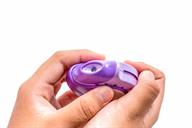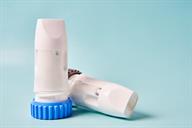How to Use a Dry Powder Inhaler
A dry powder inhaler (DPI) is a handheld device that lets you breathe (inhale) medicine into your lungs. The medicine used is a very fine powder. You may not feel it going into your lungs. This is normal.
You may need a DPI as part of your long-term treatment to prevent or control breathing problems. In most cases, the medicine in a DPI does not take away sudden symptoms.
What are the risks?
-
If the medicine in the DPI is a steroid, it may cause mouth sores. To prevent this, rinse your mouth after you use the DPI. Gargle and spit out the water. Do not swallow the water.
-
If you do not use your DPI in the right way, the medicine may not reach your lungs to help you breathe.
-
The medicine in the DPI can cause side effects. Read the package insert for the medicine to learn more. Ask your health care provider or pharmacist if you have more questions.
Supplies needed:
The DPI. The medicine that you inhale comes inside or with the DPI.
Some DPIs have a chamber that is already loaded with medicine (multi-dose). The DPI has a set number of doses (inhalations).
Some DPIs have medicine capsules that need to be loaded into them. The DPI will need to be loaded each time a dose is needed (single dose).
How to use a DPI
The steps for use will depend on the type of DPI you have. In general, follow these steps:
Keep the DPI level.
- Load the medicine into your inhaler if you need to.
If you have a disc inhaler, the medicine is loaded when you slide the lever. A disc inhaler is shaped like a disc.
If you have a twist or flex inhaler, the medicine is loaded when you twist the inhaler.
Turn your head away from the DPI. Breathe out. Do not breathe out into the mouthpiece.
Place the mouthpiece in your mouth. Seal your lips around it.
Take a quick, deep breath in through your mouth. Do not breathe through your nose.
Hold your breath for 10 seconds or as long as you can comfortably.
Remove the DPI from your mouth. Turn your head and breathe out slowly.
Check the dose indicator number on the DPI. It should go down when you use the inhaler.
Follow these instructions at home:
Caring for your DPI
-
Keep track of your doses. When the dose counter is low, it is time to pick up a new inhaler at your pharmacy. When the dose number shows zero (0), throw the DPI away.
-
Store your DPI in a cool, dry place at room temperature. The medicine in your inhaler is a powder and must be kept dry.
-
Do not breathe into the DPI.
-
Do not wash your DPI. If the mouthpiece gets dirty, use a dry cloth to wipe it clean.
-
Use the DPI as told by your provider. Always refer to the package insert that comes with your DPI for special instructions.
General instructions
-
Take your inhaled medicine only as told by your provider. Do not use the DPI more than you are told to.
-
Do not use any products that contain nicotine or tobacco. These products include cigarettes, chewing tobacco, and vaping devices, such as e-cigarettes. If you need help quitting, ask your provider.
Contact a health care provider if:
-
Your symptoms do not get better with the DPI.
-
You have side effects from the medicine.
-
You are not sure how to use your DPI or it is not working right.
-
You have a cough that will not go away.
-
You have a very sore mouth or throat and trouble swallowing.
-
You have severe shortness of breath or trouble breathing.
-
You have chest tightness or chest pain.
-
You have an allergic reaction. Symptoms may include an itchy rash, swelling of the face or tongue, or trouble breathing.
These symptoms may be an emergency. Get help right away. Call 911.
This information is not intended to replace advice given to you by your health care provider. Make sure you discuss any questions you have with your health care provider.

